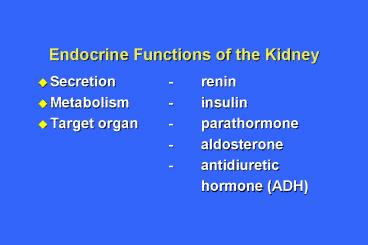Endocrine Functions of the Kidney - PowerPoint PPT Presentation
1 / 33
Title:
Endocrine Functions of the Kidney
Description:
Endocrine Functions of the Kidney. Secretion - renin. Metabolism - insulin ... Abdominal aneurysm resection. Cardiopulmonary bypass. Treatment of Acute Renal Failure ... – PowerPoint PPT presentation
Number of Views:3243
Avg rating:3.0/5.0
Title: Endocrine Functions of the Kidney
1
Endocrine Functions of the Kidney
- Secretion - renin
- Metabolism - insulin
- Target organ - parathormone
- - aldosterone
- - antidiuretic
- hormone (ADH)
2
Renal Function
- Blood flow 20 - 25 of cardiac
- output
- Glomerular filtration rate (GFR)
- 125 ml/min (normal young adult)
- Urine output 1500 ml/24 hr
3
Renal Function Tests
- Blood urea nitrogen
- normal value 10 - 20 mg/dl
- renal dysfunction gt 50 mg/dl
- Plasma creatinine
- normal value 0.7 - 1.5 mg/dl
- Creatinine clearance
- normal value 110 - 150 ml/min
4
Creatinine Clearance
- Cp x Vp Cu x Vu
- mg/dl ml/min mg/dl ml/min
5
Creatinine Clearance
- Measure
- Cp 1mg/dl
- Cu 100 mg/dl
- 24 - hour urine volume 1440 ml
- (Vu 1 ml/min)
6
Creatinine Clearance
- Cp x Vp Cu x Vu
- 1 x CL 100 x 1
- CL 100 ml/min
7
Effects of Anesthetic Drugs on Renal Function
- Decreases in RBF, GFR, urine output
- Nephrotoxicity (Fluoride ion-polyuria)
8
Chronic Renal Failure Etiology
- Chronic glomerulonephritis
- Diabetic nephropathy
- Pyelonephritis
9
Chronic Renal Failure Circulatory Changes
- Anemia (erythropoietin deficiency)
- Coagulopathy
- Platelet dysfunction
- Systemic heparinization
- Hypertension (renin release)
- Vasoconstriction (angiotensin II)
- Sodium retention (aldosterone)
10
Chronic Renal FailureMetabolic Changes
- Metabolic acidosis (phosphate, sulfate retention)
- Hyperkalemia
- Hypermagnesemia
- Hypocalcemia (from phosphate retention)
11
Chronic Renal FailureImmunosuppression
- Decreased phagocyte activity
- Effects of drugs
12
Postoperative ProblemsChronic Renal Failure
- Recurarization
- Hypertension
- Sensitivity to opioids
- Cardiac dysrhythmias
13
Causes of Perioperative OliguriaPrerenal
(Decreased RBF)
- Hypovolemia
- Decreased cardiac output
14
Causes of Perioperative Oliguria Renal (Acute
Tubular Necrosis)
- Renal ischemia
- Nephrotoxic drugs
- Myoglobinuria
- Hemoglobinuria
15
Causes of Perioperative Oliguria Postrenal
(Obstructive Uropathy)
- Bilateral ureteral obstruction
- Extravasation from bladder rupture
- Prostatism
16
Differential Diagnosis of Perioperative Oliguria
- Prerenal Renal
- Urine sodium lt 40 gt 40
- Urine osmolarity gt 400 250-300
- Urine/plasma gt 1 . 8 lt 1 . 1
- osmolarity
17
Patients at Risk of Perioperative Renal Failure
- Renal disease Multiple trauma
- Liver disease Congestive heart
- Hypovolemia failure
- Sepsis Advanced age
18
Operative Risks of Renal Failure
- Abdominal aneurysm resection
- Cardiopulmonary bypass
19
Treatment of Acute Renal Failure
- Fluid Challenge
- Dopamine infusion
- (3-5 mcg/kg/min)
- Diuretics
- Mannitol 12 . 5 g
- Furosemide 5 mg
20
Renal Disease (1)
- Glomerulonephritis
- Acute (often post-streptococcal)
- Goodpasture syndrome (vasculitis)
- Nephrotic syndrome (gross proteinuria)
- Interstitial nephritis (drug allergy)
21
Renal Disease (2)
- Polycystic kidneys
- Fanconi syndrome
- Bartter syndrome
22
Renal Disease (3)
- Renal hypertension
- Uric acid nephropathy
- Hepatorenal syndrome
23
Anesthesia for ESWL
- Immobilization
- Analgesia to T6 (regional technic)
- Effects of water immersion
- Cardiac dysrhythmias (shock waves)
24
TURP Syndrome
- Cardiovascular changes (hypervolemia)
- CNS disturbances, dysrhythmias (dilutional
hyponatremia)
25
TURP SyndromeSigns of Hemodilution
- Serum sodium
- lt 120 mEg/L
- Hematocrit decreased
26
Anesthesia for TURP
- Spinal preferred (level to T 10)
- Early detection of excessive fluid absorption
- Early detection of bladder perforation
- Postoperative analgesia (opioid)
27
Renal TransplantationPreoperative
- Hemodialysis
- Blood glucose value
- (diabetic patient)
28
Renal TransplantationIntraoperative
- Fluid 5 glucose with 0.45 NaCl
- Mannitol 12.5 g increments
29
Renal Insufficiency
- Threshold
- loss of 60 of nephrons
- Uremia
- loss of 90 of nephrons
30
Anesthetic Induction
- CNS hypersensitivity
- Hypovolemia
31
Fluid Management
- Preoperative hydration (balanced salt solution
10-20 ml/kg) - Intraoperatively 3-5 ml/kg/h
- Maintain urine output gt 0.5 ml/kg/h
- Avoid diuretics
32
Fluid Management(Anuric Patient)
- Replace insensible losses with 5 D/W
33
Renal TransplantationHazards and Complications
- Cardiac arrest (acute hyperkalemia)
- Acute immunologic rejection (DIC)
- Hematoma
- Delayed signs of rejection (fever, oliguria)

